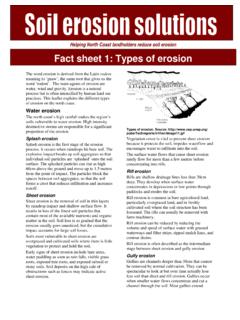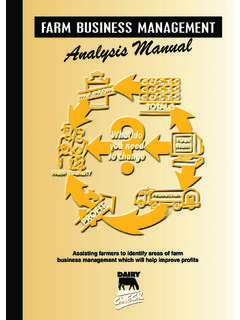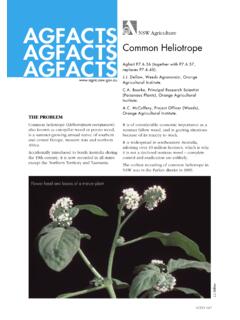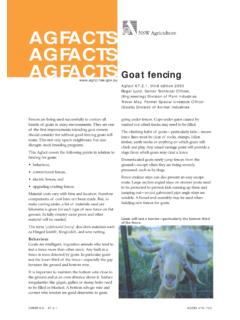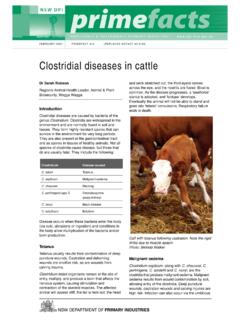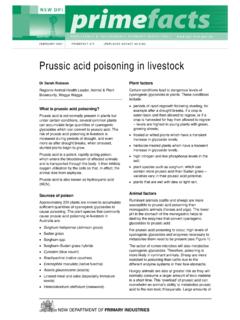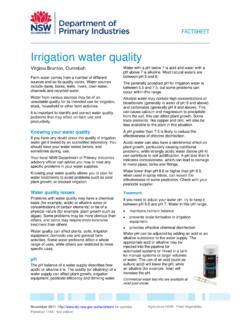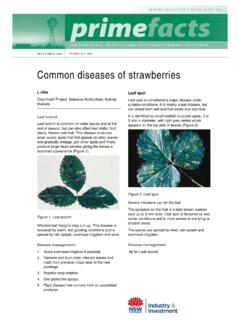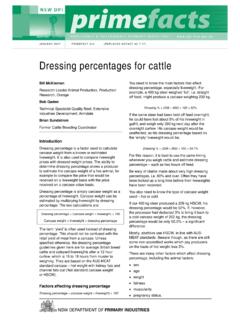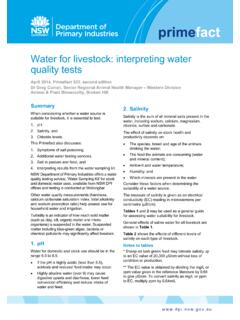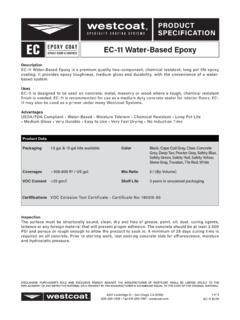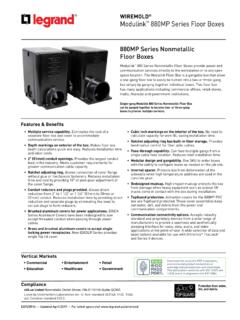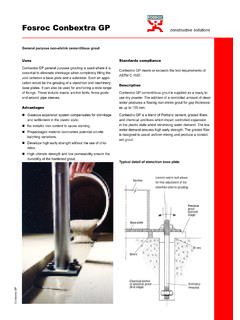Transcription of Full hand feeding of beef cattle – quantities
1 JANUARY 2007 PRIMEFACT 295 (REPLACES AGNOTE DAI-172). Full hand feeding of beef cattle . quantities Bill McKiernan program. The energy requirements of cattle depend on: Research Leader Animal Production, Production Research, Orange liveweight energy concentration of the feed (M/D). pregnancy Assessing the situation lactation The full drought phase begins when your cattle have reached the point where they should not lose growth any more weight and supplements are insufficient weather conditions. to maintain weight. Now is the time for a major reassessment. Consider the following: Calculating the feed requirement for the probability of useful feed growing if the maintenance drought breaks in the near future.
2 The first step in finding the energy needs of adult the quantity of feed required for full feeding ; cattle is to calculate the amount of feed needed to the resources required (including finance for provide sufficient energy to maintain liveweight. If buying feed, paying for labour and other cows are pregnant or lactating, adjustments to the continuing costs), and the facilities or equipment maintenance value need to be made, and these required; are discussed in Step 2 of the next section Adjusting the ration'. the potential benefit of continuing to feed certain classes of stock. To calculate the feed requirement for maintenance, Cost your program on a monthly basis. You can you need to know the energy content of the feed or reassess the stock you are going to feed, and feeds to be used.
3 A guide to the energy contained perhaps reduce numbers again, to make available in various feeds can be found in Table 2 at the end funds go further. of this Primefact. The values given are average values. Whenever possible, a feed analysis is From here on, the cost of a feeding program will recommended, as there can be considerable increase, particularly during periods of production variation. information on testing laboratories can be stress such as calving and lactation, so it may be obtained from your local NSW Department of necessary to cull more heavily. Primary Industries office. Once the energy content of the feed is known, use Energy requirements for maintenance Figure 1, at the end of this Primefact, to predict the Energy is needed by animals for all body functions.
4 Amount of feed needed to meet maintenance Energy is measured in megajoules (MJ). Animal requirements. Where more than one feed is being requirements are assessed as megajoules of fed, the following procedure is used to calculate the metabolisable energy' (MJ ME). Energy in feed is energy content of the mixed ration. It is this number assessed as megajoules of metabolisable energy which is then used in Figure1. per kilogram of dry matter' (MJ ME/kg DM, or simply M/D). Example In drought, it will be the energy component of feed A ration contains 80% wheat ( M/D) and 20%. that will be the most limiting. Addressing this need clover hay ( M/D). The calculation is as follows: is the first requirement in a drought feeding Energy content = (80 ) + (20 ) = M/D Step 2.
5 Allowance for pregnant and lactating 100 cows Using Figure 1, first calculate the feed requirements To use Figure 1, place a ruler on the appropriate for maintaining a non-pregnant cow. Then increase point which represents the liveweight of the animal this amount of feed by the percentage factor given under assessment (left-hand vertical line of the below to determine the corrected amount of feed figure), then run the ruler through the energy required by a pregnant or lactating cow: content of the feed (centre angled line). The point where the ruler cuts the right-hand line indicates Cow 6 months pregnant: add 20%. how much feed (in kilograms per day) needs to be Cow 8 months pregnant: add 40%.
6 Fed to maintain liveweight. Cow with calf at foot: add 60%. Calculating the as fed' amount Step 3. Allowance for cold stress The calculation in the previous section assumes the feed is 100% dry matter. All feeds will contain During cold, bleak weather, increase the rations for some moisture, and this needs to be compensated all classes of stock by 20%. The extra feed should for when determining how much of the fodder to be provided as hay. feed. Wet feeds such as silage or vegetables should be Dry matter percentages for various feeds are also fed in greater quantity in proportion to their found at the end of this Primefact. To determine the moisture content. See the section Calculating the amount of a particular fodder or ration to feed, take as fed' amount'.
7 The calculated amount from Figure 1, multiply it by 100, and then divide this by the dry matter feeding for survival percentage. This is commonly known as the as fed' amount. feeding grain for survival involves a certain amount of stock training and gradual introduction of grain, otherwise deaths will occur. The success of Example grain feeding depends largely on starting well kg DM/day, where the dry matter percentage is before cattle weights fall to their critical level. 90%: Critical survival weight As fed' amount = 100 90 = kg When body weight falls to a critical point, called the As a general rule, to adjust the amount of feed to critical survival weight, the body reserves are an as fed' weight: almost depleted, and you must be prepared to increase feed substantially to prevent stock losses.
8 For grains/hay: As fed' amount = The critical survival weights for medium-maturity feed required (kg DM /day) 100 90 British Breed cattle are as follows: Weaners 150 kg For silages: Yearlings 225 kg As fed' amount =. feed required (kg DM /day) 100 30 Adult dry stock 300 kg Breeders 350 kg Adjusting the ration It is recommended that cattle be maintained above these weights by feeding according to the Step 1. Ration for dry beast requirements given in Table 1. Extended feeding of As described in the previous section, use Table 2 to cattle that are at critical survival weights does not get the energy (M/D) value of the feed. Then place allow for unexpected problems. a ruler on Figure 1 at your values for Liveweight Adjustments should be made for larger framed or (kg)' and Feed M/D', and read off the Feed higher producing cattle .
9 Note that individuals in the required' from the right-hand side. Then adjust for herd may be below these weights and still be in dry matter content to calculate the as fed' quantity. satisfactory condition. PRIMEFACT 295, FULL HAND feeding OF BEEF cattle quantities 2. Table 1. Maintenance(a) feed requirements ( as fed') for full hand feeding of cattle Feed options: minimum weight (kg) per day as fed'. Class of stock and Grain Hay 50:50 80:20 Silage Expected weight bodyweight (12 ME) ( ME) grain:hay mix grain:hay mix (30% dry matter gain/day OR OR OR OR and 9 ME). (b). Weaners kg (200 kg). (b). Yearlings kg (250 kg). Adult dry stock nil (400 kg). Breeders, late nil pregnancy (425 kg). Breeders, lactating (c) nil (425 kg).
10 (a) During periods of cold weather, these levels should be increased by 20% using hay if possible (3 kg hay is equivalent to 2 kg grain). (b) For young stock, protein levels should be at least 9% for them to continue growing. It would be better to lot feed these cattle for production. (c) High levels of grain cause cows to milk poorly. Feed at least kg hay/hd/day with kg grain/hd/day. Suitability of various feeds molasses is the main feed, cattle usually regulate themselves to about 1 kg per 100 kg of bodyweight Grains per day. Some roughage should be available to avoid molasses toxicity. Grain is usually the most economical type of feed to use during drought. Wheat, barley, oats, rice, Protein-rich meals maize and sorghum are energy-rich feeds of similar nutritive value.
